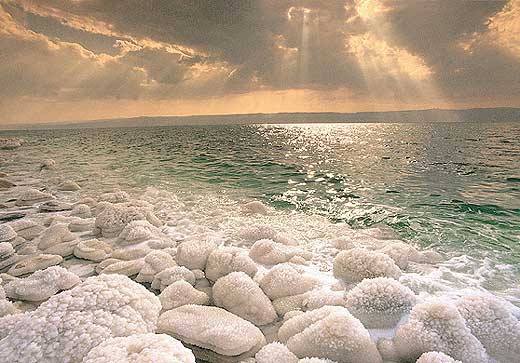

For nearly 2,000 years, the contour and coastline of the Dead Sea remained virtually unchanged from the days when the famous Dead Sea scrolls were stashed in nearby cave. But in the last 50 years, since the great diversions upstream to irrigate a growing economy, the river flow that fed the lake has decreased to 8 percent of its former pour. The Dead Sea is dropping about a yard a year, and its surface area is just a third of what it once was. The Global Nature Fund has declared the Dead Sea “Threatened Lake of the Year” for 2006.
[…] it looks like a detonated mine field. It is a garden of sinkholes: As the lake has receded, it has sucked the water from the underbelly of the shoreline, causing the earth to collapse. There are over 1,000 sinkholes on the west side of the Dead Sea, and more appear every day.
So, how is anyone supposed to bring the Dead Sea back to life? The answer, as for most things in Israel, is tourism, says Gidon Bromberg [Friends of the Earth Middle East].
“Tourism is the engine that will clean up the environment,” Gidon proclaims, and he may be right. Gidon and his colleagues at FOEME have been working on a plan to designate the Dead Sea and the Jordan River a UNESCO World Heritage Site, and Israel, Jordan and Palestine, the stakeholders, have expressed real interest.
The designation would not only ensure proper environmental management and conservation, but would attract more tourists — religious, historical and environmental. These are the sorts of travelers who become emotionally invested in a place they visit, and become active constituents for its preservation.
Nature tourism depends upon a healthy environment. This type of tourism, if developed properly, can become an economic alternative to agriculture, which supplies just 2 percent of Israel’s GDP but accounts for 90 percent of the water diversion of the Jordan’s flow. If farmers divert less, more clean water pours down the Jordan, the Dead Sea returns, and this storied ecosystem attracts more tourists.
More tourists good for ecosystem. Fewer tourists bad for ecosystem. Got it. But what was that thing about Israel, Jordan and Palestine working together to make this happen? I’m not sure how tight the ecologists from these three political entities are. But maybe if the three can unite to keep something dead alive, they can unite to try to preserve life in other areas. Maybe.
Alternate solution: when the Jewlicious birthright trips visit the Dead Sea area, each participant dumps a gallon each of salt and water (or one bottle of saline solution) into the sea. You know, a low-income version of water preservation. Not ecologically sound? Well, consider it a jumping-off point for discussion.






But what was that thing about Israel, Jordan and Palestine working together to make this happen? I’m not sure how tight the ecologists from these three political entities are.
Much tighter than you might think, especially the first two.